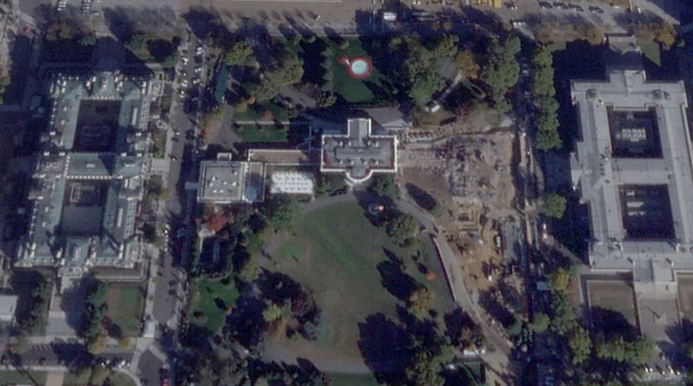The Politics of Seeing
- Ocean Hoptimism

- Oct 24
- 6 min read
How Optics Shape Reaction, and What That Can Teach Ocean Work

The East Wing is rubble. However you feel about the presidency, watching excavators bite into the White House has detonated a public response faster than any press briefing could catch up. It’s not that presidents haven’t undertaken big changes before—Truman literally gutted and rebuilt the interior between 1948 and 1952—but the meaning of seeing it happen, everywhere, all at once, is different now.
What we’re seeing isn’t just construction—it’s continuity. The East Wing demolition is only the most recent chapter in a longer story of erasure, where our built and natural heritage are quietly rewritten under the banner of “renewal.” As the Center for American Progress has documented, the purge of diverse narratives from museums, monuments, and national parks has been underway for years and will likely continue. When those public spaces are stripped of Indigenous, Black, immigrant, and queer histories, the nation’s self-portrait narrows. What disappears from the landscape disappears, eventually, from memory.
The wholesale erasure we’re witnessing in plain sight isn’t slow or silent. The demolition of the East Wing marks a shift from quiet revision to public spectacle: a tear-down of national pride and identity carried out under floodlights and phone cameras. In a world of continuous video, satellite imagery, and ambient outrage, there’s no buffer between act and interpretation. Optics don’t just frame the story; they are the story.

The image itself has become the argument.
Why This Looks Worse Than "a Renovation"
Let’s bracket for a moment the questions of legal process, costs, and transparency. Those matter. But the velocity of reaction is being driven by what semioticians would call the sign system: images of demolition, the symbolic site being altered, the sense of irreversibility communicated by rubble. People aren’t experiencing a policy proposal; they’re experiencing the crash of stone, the absence of rooms where staff once worked, and the immediate narrative of loss. That’s why even statements that the project is privately funded or “respectful of history” aren’t neutralizing the public mood, because the dominant sign (destruction of a historic wing) overwhelms counter-signs (assurances, renderings, future benefits).
There’s precedent for major change. Truman’s overhaul gave the Executive Mansion a new steel spine, deeper foundations, more rooms, and a televised tour at the end. But crucially,
the public mostly encountered the transformation after the fact, in curated form. The semiotics of “reinforcement within” read as prudence; the semiotics of “visible teardown” read as rupture. In politics, that difference is not pedantic; it’s the whole ballgame.
Optics Not As Spin, But As Social Physics
“Optics” migrated from physics into political language to describe how decisions look, not just what they are. That shift isn’t frivolous; it recognizes that democratic legitimacy is partly performative: maintained by rituals, symbols, and a citizenry’s sense that institutions honor shared meaning. When pundits say “the optics are bad,” what they really mean is: the signs being broadcast carry meanings that coordinate action against you—protests, lawsuits, donor backlash. The sign outruns the substance.
Semiotically, three layers intertwine whenever power meets the public eye. There is the semantic layer: what leaders intend an act to mean, as in the official language of “modernization” or “expansion.” Then comes the pragmatic layer: the ripple of behavior that follows, as audiences mobilize, protest, or retreat in response to what they’ve seen.
And finally, there’s the layer that reveals what gets lost: the meanings closed off by the way the act is staged. When the first public image is one of demolition, for instance, it becomes nearly impossible for viewers to imagine the project as “careful stewardship.”
Each layer feeds the next, forming a loop in which interpretation and intention collide—where the story being told is often not the one being written. In short: when the first widely shared image is a wrecking claw cutting through an American icon, you’ve surrendered your semantic intent to a more potent visual that tells its own story.
The Real Time Problem
The modern information environment intensifies all of this. We’re not in a two-step flow (decision → press release → next day’s paper) anymore. We live in an “all-flows, all-at-once” ecology where satellite shots, smartphone clips from construction workers, and influencer commentary collapse time. By the time an official briefing arrives, meaning has gelled. That’s why the current demolition is provoking a faster, broader, and more cross-partisan reaction than most administrative building projects: the “live feed” of loss outruns the “later promise” of replacement.
What This Can Teach Ocean Communicators
Here’s where Ocean Hoptimism, and ocean work more broadly, can learn.
The image pre-writes the headline. Show a healthy coral reef, and people infer resilience; show a bleached reef, and people infer inevitability. Our audiences often meet our work first as an image. If we want “hope with teeth,” we must pair visuals of harm with visuals of credible repair in the same breath, not days later. Otherwise, despair captures the frame.
Sequence is substance. In the White House case, demolition came before design transparency. In conservation, we can flip that: lead with local community representatives at the table during the planning stage, then develop the intervention. When communities are co-designers of the “why” and “how” before we show the roll-out, we preserve the semantic space for local leadership rather than colonial or parachute conservation.
Make the invisible visible—on purpose. Truman’s team eventually televised the rebuilt home. In ocean work, our “exteriors” (open water) hide the inner work (monitoring, governance, enforcement, finance). If the public only ever see “nothing changing” at the surface, they conclude nothing is happening. Show the scaffolding: policy drafts, community meetings, before/after data. Legibility is legitimacy.
Honor the altar pieces. The East Wing is not just drywall; it’s where First Lady staffs worked, where visitors entered, where the site’s ritual life unfolded. In marine spaces, we have our own altar pieces: subsistence fishing coves, ancestral tidepools, beloved surf breaks, sacred ocean places like the Hawaiian heiau and other coastal sites of ceremony and connection, even iconic species with deep cultural integration. When an intervention involves those, we must narrate our respect ahead of the conservation work. Ritual meaning is a stakeholder.
Design for the three semiotic layers. Semantic: be explicit (“We’re removing derelict pilings to restore eelgrass; here’s the timeline and what will look different.”). Pragmatic: call the action you want (“Sign up for Saturday’s planting; email the harbor commission by Friday.”). Framing change: leave space for other meanings to stay alive (“This isn’t a ‘no-fishing’ ban—it’s a seasonal recovery zone, and here’s how it helps the next generation of fishers.” or “This isn’t anti-development—it's anti-erosion, meant to keep the coastline and its culture standing”).
Ocean Hoptimism's Role: Optics With Integrity
Ocean Hoptimism was built to push back against doomscroll fatalism without sugarcoating reality. That balance, truth told with heart, is an optics choice, and one that carries responsibility. A good story doesn’t just inform; it frames how people feel about possibility. So in the months and years ahead, we—the ocean conservation community—should be more deliberate about the optics we create and share. The images and narratives we put into the world shape how people feel about the ocean, what they believe is possible, and whether they see themselves in the story.
First, pair every “uh-oh” with a “here’s the fix.” If we post about deep-sea mining risks or coral bleaching, that same thread should also highlight the people working the problem and the small actions anyone can take that week. The optic shouldn’t be you’re doomed; it should be you’re invited to be part of the solution.
Second, show the scaffolding of hope. Behind every success are drafts, meetings, and volunteers. Let’s make that visible: the reef survey setups, the community workshops, the first coat of paint on a shoreline sign. That’s our televised tour of the “new foundation,” proof that hope isn’t naive... it’s under construction.
And third, use symbols that scale. The White House is powerful because it stands for more than itself. We can do the same. A CTD sensor aboard the Western Flyer. A San Francisco Baykeeper patrol boat slicing through morning fog. A kid’s notebook doodle of a tidepool anemone. These are our micro-icons. Ordinary scenes that carry the extraordinary message: this is ours; this is us. Symbols make memory, and memory makes movements.
Optics with integrity don’t hide the hard parts, they make the process legible, relatable, and shared. That’s the visual language of belonging. If we can keep showing the scaffolding of hope instead of just the highlight reel, we might just build something that lasts longer than the next crisis cycle.
A Final Note on Responsibility
It’s tempting to dismiss “optics” as shallow spin. But when a democratic public learns about the world visually and socially, optics are a civic responsibility. They’re the bridge between substance and meaning. The current East Wing episode is a case study in how ignoring that bridge invites backlash, even before the policy questions land. The lesson for us is not to manipulate symbols, but to steward them: to choose frames that tell the truth and carry people toward useful action.
We will keep doing that: showing harm without spectacle, progress without PR fog, and community without gatekeeping. Because in ocean work, as in public life, legitimacy depends on what people see us doing—not just on what we say we intend to do. And that, ultimately, is the kind of optics worth committing to.
Seeing clearly is the first act of care.



Comments